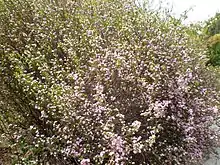Coleonema pulchellum
Coleonema pulchellum, commonly known as confetti bush, buchu, diosma or breath of heaven, is a shrub which is endemic to South Africa.[2][3]
| Coleonema pulchellum | |
|---|---|
 | |
| Scientific classification | |
| Kingdom: | |
| (unranked): | |
| (unranked): | |
| (unranked): | |
| Order: | |
| Family: | |
| Genus: | |
| Species: | C. pulchellum |
| Binomial name | |
| Coleonema pulchellum I.Williams[1] | |
| Synonyms | |
| |
Description

It is woody, evergreen and rather dense shrub that is erect in posture that grows to between 0.8 and 1.6 metres (2 ft 7 in and 5 ft 3 in) high. It forms a single stem at the base, from where numerous thin and erect branches grow. The aromatic leaves are like needles and are 4 to 5 times longer (8-10 mm) than they are wide (0.8 mm). The petiole is 1 mm long. The dwarf variety 'Dwarf Pink' grows between 0.6 and 0.9 metres (2 ft 0 in and 2 ft 11 in).
The flowers are solitary, terminal in short axillary twigs or in small twigs, often dense towards the top of the branches. They are pink, often white, and star-shaped (7 to 8 mm in diameter), with 5 oval petals, 5.0-5.7 mm long, each marked with a distinctive central vein. The entire shrub will be covered in pink flowers from May to October, attracting bees, butterflies and other insects. The fruit is made up of a 5-chamber capsule, dotted with glands. There is a shiny black seed in each chamber.[2]
Taxonomy
The species was formally described in 1981 in the Journal of South African Botany.[4] Prior to this, plants in cultivation had been erroneously identified as Coleonema pulchrum.[3]
Cultivars
- 'Compactum' ('Nanum') — dwarf pink flowering form growing to 1m
- 'Rubrum' ('Red Form') — red flowering form
- 'Sunset Gold' — dwarf form with golden foliage to 75 cm high [3]
- Album' — white flowering variant
References
- "Coleonema pulchellum I.Williams". The Plant List; Version 1. (published on the internet). 2010. Retrieved 5 January 2013.
- "Coleonema pulchellum". PlantZAfrica.com. South African National Biodiversity Institute. Retrieved 5 January 2013.
- "Diosma". Burke's Backyard. Retrieved 5 January 2013.
- "Coleonema pulchellum". Australian Plant Name Index (APNI), IBIS database. Centre for Plant Biodiversity Research, Australian Government, Canberra. Retrieved 5 January 2013.
![]() Media related to Coleonema pulchellum at Wikimedia Commons
Media related to Coleonema pulchellum at Wikimedia Commons